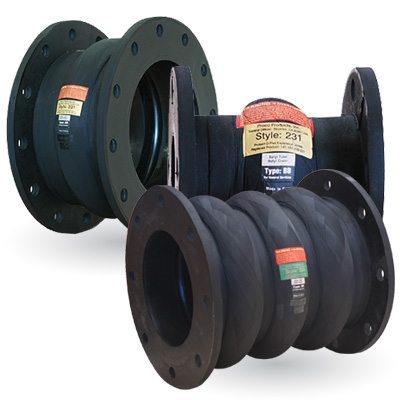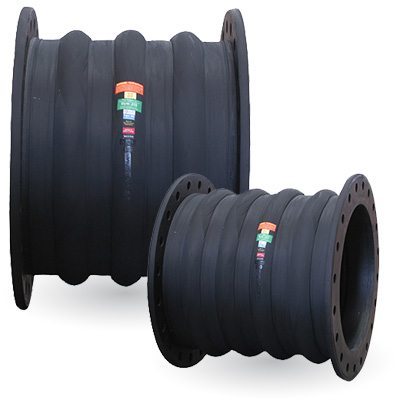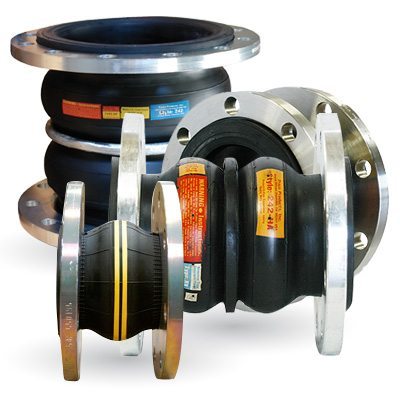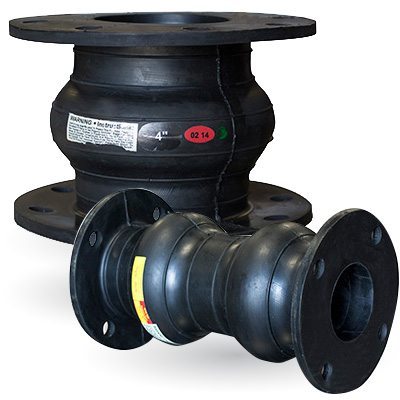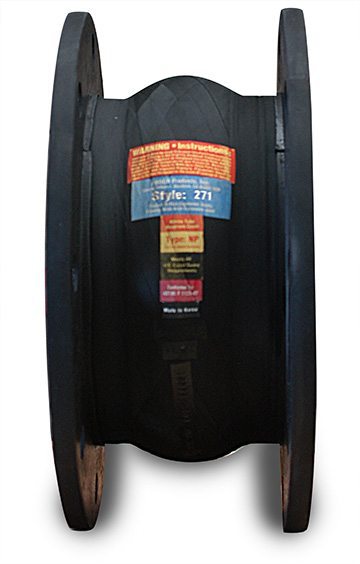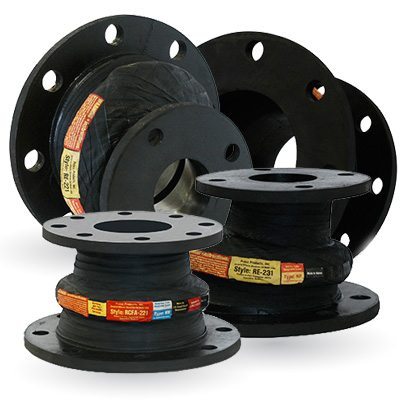Rubber Expansion Joints
What is a rubber expansion joint?
A rubber expansion joint is a flexible connector to absorb noise, shock, vibration, physical and thermal energy. Made of natural or synthetic elastomers it may be internally reinforced with fabrics and metal for strength and pressure resistance whilst metal reinforcement may be used externally for movement control.
Why Use a Rubber Expansion Joint?
Rubber expansion joints offer flexibility allowing concurrent movements, isolation of vibration, reduction of noise, resistance to abrasion and chemical erosion within fluid systems.
Here are the key benefits of rubber expansion joints:
Movement Absorption
Rubber joints can absorb greater movements when compared to similar length metal expansion joints. Equipment such as pumps, compressors and piping can move out of alignment due to wear and settling of their supporting structures. Rubber expansion joints can routinely manage the resulting lateral, torsional and angular movements whilst strategically located rubber expansion joints can mitigate thermal expansion and contraction movements. Metal joints typically have a lower lateral movement capability and the allowance for movement offered by rubber expansion joints has positive benefits in extending system life and maintenance intervals.
Vibration Reduction
Reducing vibration is important to prevent unbalanced forces building up to a level where they can damage a fluid system. Rubber pipe and expansion joints dampen these disturbances and provide resistance against shock stress from hydraulic surge and water hammer.
Sound Reduction
As systems age and wear, imbalances occur which cause unwanted noise. Rubber expansion joints dampen sound transmission with their rubber to steel interface. When compared to full metal joints, thick-walled rubber expansion joints offer a much higher reduction of sound transmission.
Corrosion, Abrasion and Erosion Resistance
Metal joints are typically thin wall elements, having a wall thickness anywhere between 0.15mm to 2mm. Rubber joints are thicker, from 12mm to over 25mm. Metal expansion joints are susceptible to chemical erosion and abrasion whereas rubber joints are resistant to abrasion and erosion.
A wide variety of natural, synthetic, and special purpose elastomers and fabrics are available to create high performance rubber expansion joints to meet challenging operating conditions. Special polymers resist chemicals, oil, sunlight, acid fumes, ozone and external coatings can be added for further protection.
Expansion joints may use PTFE (polytetrafluoroethylene) and FEP (fluoroethylene propylene) liners within the joint body. When fluoroplastics are used in rubber expansion joints this results in better thermal stability, low friction and resistance to corrosive fluids, chemicals, abrasion and erosion.
Fatigue Resistance
The ability to flex and absorb gives rubber expansion joints a distinct advantage over metal joints since natural and synthetic elastomers are not subject to fatigue breakdown, loss of ductility or electrolytic reaction. This results in a long-lasting expansion joint.
Ease of Installation
Rubber expansion joints are light in weight compared to metal expansion joints, making them easy to handle and install. The vulcanized rubber and fabric flanges of elastomeric expansion joints are integrated and therefore do not require additional gaskets which also eliminates the need for ongoing gasket maintenance checking. Additionally, elastomeric expansion joints can equalize the uneven surfaces of the pipe flange to provide a gas tight seal.
Industry Applications
Rubber expansion joints appear in all fluid systems. Rubber expansion joints relieve stress from movement, isolate vibration, reduce noise and compensate for misalignment in piping systems. Rubber expansion joints do not replace metal expansion joints in all applications but are recognized as the best choice for many applications involving high vibration and sound dampening.
Here are examples of applications that utilize rubber expansion joints:
|
|
|
|
|
|
|
|
|
|
|
|
|
|
|
|
|
|
Construction Terms for Rubber Expansion Joints
Carcass
The body of the expansion joint consisting of fabric and / or interior metal reinforcement.
Cover
The natural or synthetic rubber exterior of the joint which protects the carcass from damage.
Fabric Reinforcement
A synthetic or natural fabric between the tube and cover that flexibly supports the expansion joint for movement or pressure.
Metal Reinforcement
Solid rings or wire embedded in the carcass which strengthen the expansion joint to withstand high pressure or vacuum.
Tube
A protective, leak-proof lining tube that extends through the bore to the outside edges of the flanges to eliminate the possibility of the fluids penetrating the carcass and weakening the fabric.
Types of Rubber Expansion Joint
Arch Type Rubber Expansion Joints
Arch type rubber expansion joints are named from the thick area of elastomer molded into the shape of an arch. The carcass of the joint between the arch is usually supported by metal rings or wire to resist pressure.
Typical arch type rubber expansion joints are single wide arch and multiple wide arch types, the latter for use in longer length joints. As the length of an expansion joint span increases, up to a recommended maximum of four arches can be used to accommodate movement over long lengths.
Rubber arch expansion joints are constructed with an integral flange with fixing holes drilled to match the pipework flanges to form a tight seal without gaskets.
Joint variants may also incorporate lateral offset features or reducer connections to connect pipework of unequal diameters up to a recommended 20-degree reduction along the length of the joint.
PTFE Lined Expansion Joints
Spool Arch type joints are available with fluoroplastic liners of TFE and/or FEP. The liners cover all internally exposed surfaces, and the compounds provide resistance to almost all chemicals carried within the expansion joint.
Sleeved Arch Type
Sleeved joints slide on to the straight ends of an open pipe and are secured with clamps. They incorporate capped sleeve ends with an inside dimension equal to the outside dimension of the pipe. The main application is for low to medium pressure or medium vacuum systems.
Non-Metallic Reinforced Rubber Expansion Joint
Whilst having a similar arch construction to the spool arch type, this type of expansion joint achieves pressure resistance from extended flange rings which enclose part of the body of the joint to compensate for the lack of internal wire or ring reinforcement within the carcass.

